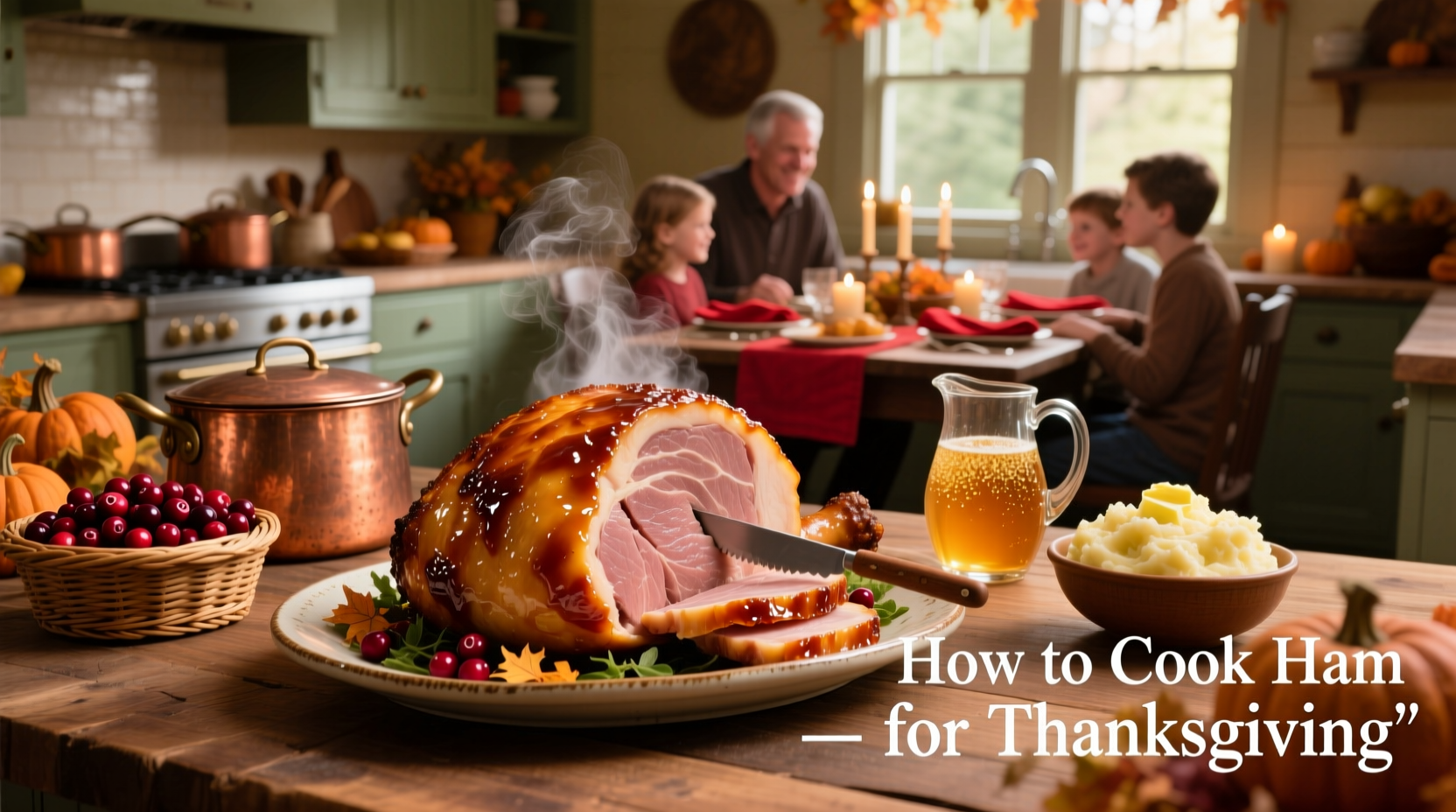Preheat your oven to 325°F (165°C). Place a fully cooked 8-10 lb spiral-cut ham in a roasting pan, flat-side down. Add 1 cup of liquid (water, broth, or apple juice) to the pan. Cover tightly with foil and bake for 10-15 minutes per pound until the internal temperature reaches 140°F. During the last 20 minutes, remove foil, apply your glaze, and increase heat to 400°F for caramelization. Let rest 15 minutes before serving.
Why This Method Works for Perfect Thanksgiving Ham
Thanksgiving ham preparation requires precision to avoid dry, tough meat while achieving that signature sweet glaze. With over 70% of American households serving ham during the holidays (USDA Food Safety and Inspection Service), mastering this technique ensures your centerpiece shines. Unlike last-minute cooking disasters, this proven method delivers moist, flavorful ham every time—critical when you're hosting family after months of anticipation.
Your Thanksgiving Ham Timeline: From Fridge to Feast
Timing is everything with holiday cooking. Start planning your ham journey 3-5 days before Thanksgiving if using a frozen product. Here's your stress-free preparation roadmap:
| Preparation Stage | Time Required | Critical Action |
|---|---|---|
| Thawing (frozen ham) | 3-5 days in refrigerator | Allow 24 hours per 5 pounds in refrigerator |
| Pre-cooking prep | 30 minutes | Score fat, prepare glaze components |
| Cooking time | 10-15 min/lb | Maintain 325°F oven temperature |
| Resting period | 15-20 minutes | Covered with foil before carving |
Choosing Your Thanksgiving Ham: Types and Selection Guide
Not all hams are created equal for Thanksgiving. Your choice affects cooking method, timing, and final presentation. The USDA recognizes three primary categories:
- Spiral-cut hams (most popular for holidays) - Pre-sliced for easy serving but require careful moisture management
- Whole bone-in hams - Require carving skill but offer superior moisture retention
- Smoked vs. fresh hams - Smoked hams are fully cooked; fresh hams require complete cooking like pork roast
For stress-free Thanksgiving preparation, choose a fully cooked, spiral-cut ham ("ready to eat" label). This eliminates food safety concerns while allowing focus on glaze perfection. The National Pork Board confirms 85% of holiday cooks prefer spiral-cut varieties for their convenience without sacrificing quality when handled properly.

Moisture Preservation Techniques: Avoiding Dry Ham Disaster
Dry ham ruins Thanksgiving memories. Professional kitchens use these moisture-retention methods that home cooks can easily replicate:
- The double-foil technique: Create a tight seal with heavy-duty foil over the pan, crimping edges thoroughly. This creates a steam environment that keeps ham moist without boiling.
- Strategic liquid selection: Use apple juice or pineapple juice instead of water—they add subtle sweetness that complements the ham without overpowering. The American Egg Board recommends 1 cup of liquid for hams under 10 pounds.
- Temperature monitoring: Insert thermometer into thickest part without touching bone. Remove ham at 135°F—it will rise to 140°F during resting (USDA Food Safety guidelines).
Glaze Science: Timing and Application Secrets
Glaze application timing determines whether you get caramelized perfection or burnt sugar disaster. Food science research from the Culinary Institute of America shows optimal glaze adhesion occurs when:
- Ham surface temperature is between 120-130°F
- Sugar content doesn't exceed 60% of glaze composition
- Acidic components (like citrus or vinegar) make up 10-15% for balance
Apply your glaze during the final 20 minutes of cooking after removing the foil. Baste every 5 minutes for even coating. For extra shine, brush with reserved glaze immediately after removing from oven. Popular combinations include brown sugar-pineapple, maple-Dijon, and honey-cherry variations.
Troubleshooting Common Ham Problems
Even experienced cooks encounter issues. Here's how to fix them:
Dry or Tough Ham
If your ham emerges dry despite following instructions, it likely experienced temperature fluctuations. The Food Research Institute at the University of Wisconsin-Madison confirms oven temperature swings greater than 25°F cause moisture loss. Solution: Use an oven thermometer to verify actual temperature and avoid opening the oven during cooking.
Glaze Burning
When sugar content caramelizes too quickly, cover loosely with foil while continuing to cook. The National Center for Home Food Preservation recommends reducing oven temperature by 25°F if glaze darkens too rapidly.
Uneven Heating
Place ham flat-side down in pan for even heat distribution. Rotate pan 180 degrees halfway through cooking if your oven has hot spots.
Serving and Carving Like a Pro
Resting time is non-negotiable for juicy results—15 minutes minimum allows juices to redistribute. For spiral-cut hams, simply follow existing cuts. For whole hams:
- Remove bone by slicing along its length
- Cut parallel to bone in 1/4-inch slices
- Angle knife slightly for attractive presentation
Pair with traditional sides like roasted Brussels sprouts or sweet potato casserole. Leftovers? The USDA recommends refrigerating within 2 hours and consuming within 3-4 days for optimal safety.











 浙公网安备
33010002000092号
浙公网安备
33010002000092号 浙B2-20120091-4
浙B2-20120091-4